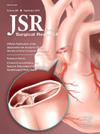胰腺胰岛素瘤切除术后住院血糖变化趋势
IF 1.7
3区 医学
Q2 SURGERY
引用次数: 0
摘要
摘要:胰岛素瘤切除术后,患者在医院可能出现术后高血糖。手术后立即发生高血糖的预测因素和趋势尚不清楚。方法:我们对2010年至2023年接受远端胰腺切除术、去核或乙醇消融治疗孤立性良性胰腺胰岛素瘤的患者进行了一项单中心回顾性研究。分析术后住院血糖趋势和高血糖正常化的预测因素。结果117例患者:51%行远端胰腺切除术,42%行胰腺核切除,7%行乙醇消融。在住院期间,73%的患者术后出现高血糖,在出院前恢复正常,24%的患者持续高血糖直到出院,3%的患者血糖正常。在血糖正常化的患者中,达到正常化的中位时间为35小时(四分位数间距=[16.3,81.8])。手术5天内血糖恢复正常的患者胰岛素瘤(中位数= 1.5 cm)明显小于手术未恢复正常的患者(中位数= 1.8 cm, P = 0.02)。手术5天内血糖正常化的预测因素包括肿瘤体积变小(优势比= 0.47,95%可信区间= [0.21,0.93];P = 0.05)和年龄更小(优势比= 0.97,95%可信区间= [0.94,0.99],P = 0.04)。老年(B = 1.2, P = 0.02)和男性(B = 44.7, P = 0.02)与血糖正常化时间延长相关。结论大多数患者在胰岛素瘤切除术后立即出现一过性高血糖,平均在手术后35小时内消退。较小的肿瘤大小与术后早期血糖正常化相关,而较大的年龄与术后早期高血糖延长相关。这些发现可能使患者和外科医生更好地预测良性胰岛素瘤手术治疗后的住院血糖趋势。本文章由计算机程序翻译,如有差异,请以英文原文为准。
In-Hospital Postoperative Glycemic Trends After Pancreatic Insulinoma Resection
Introduction
Following resection of insulinoma, patients may develop postoperative hyperglycemia in the hospital. Predictors and trends of hyperglycemia immediately following surgery are poorly understood.
Methods
We conducted a single-center retrospective study of patients who underwent distal pancreatectomy, enucleation, or ethanol ablation for solitary benign pancreatic insulinoma from 2010 to 2023. In-hospital postoperative glucose trends and predictors of hyperglycemia normalization after surgery were analyzed.
Results
We identified 117 patients: 51% distal pancreatectomies, 42% enucleations, and 7% operative ethanol ablations. During their hospitalization, 73% of patients developed hyperglycemia postoperatively that normalized prior to discharge, while 24% had persistent hyperglycemia until discharge and 3% were normoglycemic. Of patients with glucose normalization, median time to normalization was 35 h (interquartile range= [16.3, 81.8]). Patients with glucose normalization within 5 days of surgery had significantly smaller insulinomas (median = 1.5 cm) than those without (median = 1.8 cm, P = 0.02). Predictors of glucose normalization within 5 days of surgery included smaller tumor size (odds ratio = 0.47, 95% confidence interval = [0.21, 0.93]; P = 0.05) and younger age (odds ratio = 0.97, 95% confidence interval = [0.94, 0.99], P = 0.04). Older age (B = 1.2, P = 0.02) and male gender (B = 44.7, P = 0.02) were associated with prolonged time to glucose normalization.
Conclusions
Most patients develop transient hyperglycemia immediately after insulinoma resection which resolves, on average, within 35 h of surgery. Smaller tumor size is associated with glucose normalization while older age is associated with prolonged hyperglycemia in the early postoperative period. These findings may enable both patients and surgeons to better anticipate in-hospital glucose trends after surgical management of benign insulinoma.
求助全文
通过发布文献求助,成功后即可免费获取论文全文。
去求助
来源期刊
CiteScore
3.90
自引率
4.50%
发文量
627
审稿时长
138 days
期刊介绍:
The Journal of Surgical Research: Clinical and Laboratory Investigation publishes original articles concerned with clinical and laboratory investigations relevant to surgical practice and teaching. The journal emphasizes reports of clinical investigations or fundamental research bearing directly on surgical management that will be of general interest to a broad range of surgeons and surgical researchers. The articles presented need not have been the products of surgeons or of surgical laboratories.
The Journal of Surgical Research also features review articles and special articles relating to educational, research, or social issues of interest to the academic surgical community.

 求助内容:
求助内容: 应助结果提醒方式:
应助结果提醒方式:


